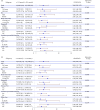The effect of fasting plasma glucose on in-hospital mortality after acute myocardial infarction in patients with and without diabetes: findings from a prospective, nationwide, and multicenter registry
- PMID: 38948897
- PMCID: PMC11211909
- DOI: 10.26599/1671-5411.2024.05.008
The effect of fasting plasma glucose on in-hospital mortality after acute myocardial infarction in patients with and without diabetes: findings from a prospective, nationwide, and multicenter registry
Abstract
Objectives: To evaluate the predictive value of fasting plasma glucose (FPG) for in-hospital mortality in patients with acute myocardial infarction (AMI) with different glucose metabolism status.
Methods: We selected 5,308 participants with AMI from the prospective, nationwide, multicenter CAMI registry, of which 2,081 were diabetic and 3,227 were nondiabetic. Patients were divided into high FPG and low FPG groups according to the optimal cutoff values of FPG to predict in-hospital mortality for diabetic and nondiabetic cohorts, respectively. The primary endpoint was in-hospital mortality.
Results: Overall, 94 diabetic patients (4.5%) and 131 nondiabetic patients (4.1%) died during hospitalization, and the optimal FPG thresholds for predicting in-hospital death of the two cohorts were 13.2 mmol/L and 6.4 mmol/L, respectively. Compared with individuals who had low FPG, those with high FPG were significantly associated with higher in-hospital mortality in diabetic cohort (10.1% vs. 2.8%; odds ratio [OR] = 3.862, 95% confidence interval [CI]: 2.542-5.869) and nondiabetic cohort (7.4% vs. 1.7%; HR = 4.542, 95%CI: 3.041-6.782). After adjusting the potential confounders, this significant association was not changed. Furthermore, FPG as a continuous variable was positively associated with in-hospital mortality in single-variable and multivariable models regardless of diabetic status. Adding FPG to the original model showed a significant improvement in C-statistic and net reclassification in diabetic and nondiabetic cohorts.
Conclusions: This large-scale registry indicated that there is a strong positive association between FPG and in-hospital mortality in AMI patients with and without diabetes. FPG might be useful to stratify patients with AMI.
© 2024 JGC All rights reserved; www.jgc301.com.
Figures



Similar articles
-
The impact of fasting stress hyperglycemia ratio, fasting plasma glucose and hemoglobin A1c on in-hospital mortality in patients with and without diabetes: findings from the China acute myocardial infarction registry.Cardiovasc Diabetol. 2023 Jul 4;22(1):165. doi: 10.1186/s12933-023-01868-7. Cardiovasc Diabetol. 2023. PMID: 37403082 Free PMC article.
-
Fasting stress hyperglycemia ratio and in-hospital mortality after acute myocardial infarction in patients with different glucose metabolism status: Results from China acute myocardial infarction registry.Diabetes Res Clin Pract. 2023 Feb;196:110241. doi: 10.1016/j.diabres.2023.110241. Epub 2023 Jan 6. Diabetes Res Clin Pract. 2023. PMID: 36623641
-
Admission Blood Glucose and 2-Year Mortality After Acute Myocardial Infarction in Patients With Different Glucose Metabolism Status: A Prospective, Nationwide, and Multicenter Registry.Front Endocrinol (Lausanne). 2022 Jun 15;13:898384. doi: 10.3389/fendo.2022.898384. eCollection 2022. Front Endocrinol (Lausanne). 2022. PMID: 35784538 Free PMC article.
-
Development of type 2 diabetes mellitus in people with intermediate hyperglycaemia.Cochrane Database Syst Rev. 2018 Oct 29;10(10):CD012661. doi: 10.1002/14651858.CD012661.pub2. Cochrane Database Syst Rev. 2018. PMID: 30371961 Free PMC article.
-
The relation of fasting and 2-h postchallenge plasma glucose concentrations to mortality: data from the Baltimore Longitudinal Study of Aging with a critical review of the literature.Diabetes Care. 2005 Nov;28(11):2626-32. doi: 10.2337/diacare.28.11.2626. Diabetes Care. 2005. PMID: 16249530 Review.
References
-
- Iwakura K, Ito H, Ikushima M, et al Association between hyperglycemia and the no-reflow phenomenon in patients with acute myocardial infarction. J Am Coll Cardiol. 2003;41:1–7. - PubMed
LinkOut - more resources
Full Text Sources
